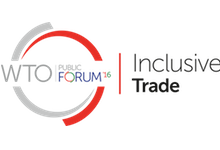Business-to-business e-commerce: Trade Implications
28 Sep 2016 17:00h - 18:30h
Event report
[Read more session reports and live updates from the 2016 WTO Public Forum.]
This session was organised by means of a partnership among three organisations: WTO Economic Research and Statistics Division (ERSD), United Nations Conference on Trade and Development (UNCTAD), and the Universal Postal Union (UPU). The session focused on business-to-business (B2B) e-commerce and its contribution to international trade flows. It discussed issues such as: how firms can use and benefit from e-commerce when trading in the global market place, what is required for more enterprises and countries to engage in such transactions, how e-commerce can help to increase a firm’s competitiveness, and what measurement frameworks may exist for ongoing monitoring.
The moderator of the session, Mr. Torbjörn Fredriksson, Officer in Charge of the Science, Technology and ICT Branch of UNCTAD, remarked that business-to-business (B2B) trade accounts for the largest amount of e-commerce transactions, according to UNCTAD.
Waleed S. Abalkhail, Chairman & Managing Director of Tradekey, affirmed that small and medium sized enterprises (SMEs) that adapted to e-commerce grew twofold compared to other companies. Every dollar invested in strategies to promoting exports brings 87 dollars in sales abroad and 300 more in the gross domestic product (GDP). For companies, some of the advantages of using electronic marketplaces are: the creation of new jobs, the capacity to obtain gains of scale, and diversification. Access to some types of trading platforms requires investment, but electronic market places online require a connection to the Internet. Electronic market places can be leveraged today by SMEs. It is the type of e-commerce that adds value to the companies by increasing their exports.
Benoit Gaillard, Digital Transformation Manager of the Global Aftermarket Solutions Division of Caterpillar, affirmed that B2B e-business in the private world means to connect processes, and make the supply chain talk to the finances department, for instance. For Caterpillar, B2B e-commerce means electronic data interchange, which allows the company to better know its costumers, as well as to conduct integrated procurement with large costumers. Buying online is the preferred channel for companies because it introduces convenience to the business world. It brings more accuracy to the catalogue of offers, and more technical information. It is also a cheaper option, because transaction costs are lower than in the traditional commerce. There is also an opportunity to connect data in real time. Live data transforms the costumer experience. In the future, Caterpillar will not wait for an equipment they sold to break down. The company will know in advance that the equipment will fail and will propose to the owner a solution in advance in order to maintain productivity. Gaillard also noted that even in developed countries, where connectivity is not an issue, many customers do not want to buy online. The problem of connectivity will be fixed, but there is a need to better understand the consumers in order to provide something meaningful to them.
Markus Wenger, Global CoE Customer Engagement and Commerce – Digital Acceleration Director MEE at SAP Hybris, expressed his preference for the expression business-to-business instead of e-commerce, because the ‘e’ is only the medium to do commerce. He explained some characteristics of the market. Sixty-two percent of companies that do B2B require self-service and assistance. This is part of a shift on behaviour, which also includes, among other things, a path of purchase that is not linear. There is need to ask questions, have back and forths, before buying. Some of the strategic priorities in the field are the need to be agile and react to trends, and the need to provide a world class customer experience, not only in interactions with customers, but also with outsiders. What is being said about the company or product on social media matters, for example. If there are negative reviews, these narratives should be countered in real time with specific offers. The Internet is an omnipresent channel that has created new demands for businesses. Customers can now easily compare prices and services online, making it easy to switch to another provider.
Andreas Maurer, Chief of the International Trade Statistics Section at the WTO, mentioned that UNCTAD, UPU, WTO and OECD have launched a joint effort to measure cross-border e-commerce. Among other things, the aim is to develop an inventory of case studies, to unify concepts and definitions, to develop conceptual frameworks, and to engage private industries in data supply and studies. The present data on e-commerce needs to be improved. In many situations, such data does not distinguish national or international e-commerce after the goods cross the border, for example. There are statistics, but analysts run into walls when they try to extract the cross-border dimension.
In the Q&A session, Fredriksson mentioned that business-to-customer (B2C) e-commerce is relatively more important in China than in the Unites States, and the UK is more similar to China on this aspect. Therefore, there is no evidence that developing countries may be stronger on B2C, and developed countries on B2B. A country by country analysis is necessary.
by Marília Maciel
Related topics
Related event

